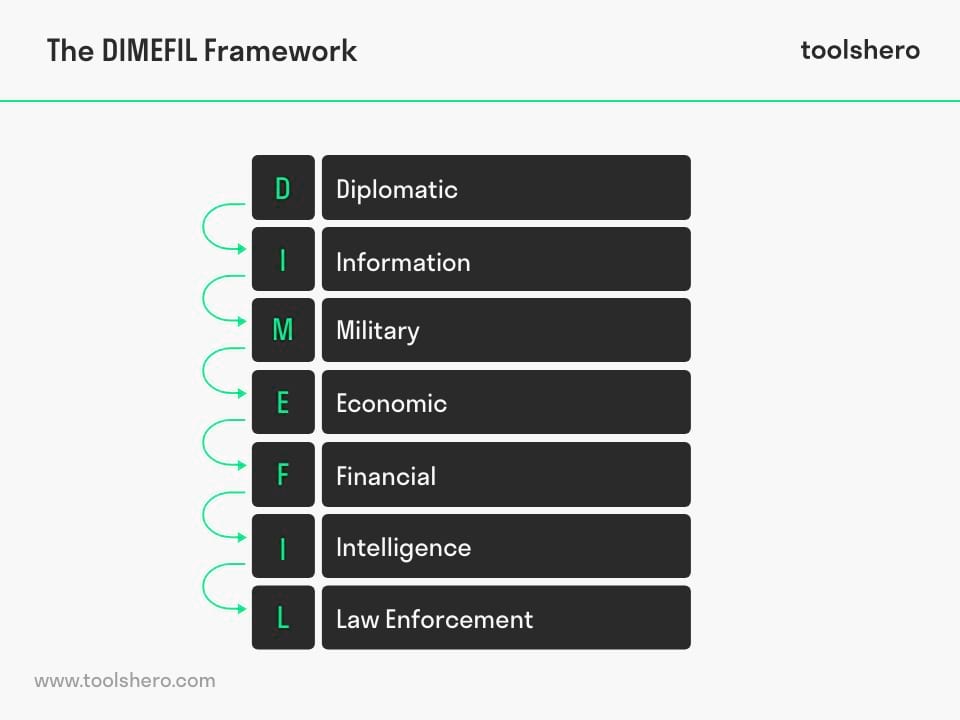DIMEFIL Framework explained

DIMEFIL framework: This article explains the DIMEFIL framework in a practical way. Next to what it is, this article also highlights the types of power. After reading, you will understand the basics of this national power assessment tool. Enjoy reading!
What is the DIMEFIL framework?
The DIMEFIL framework is a framework for describing and assessing national power. It includes a perspective on seven different elements of power.
- Diplomatic
- Information
- Military
- Economic
- Financial
- Intelligence
- Law Enforcement
The model has been used for several years to assess a country’s instruments of national power. Many policymakers and strategists know that there are many more tools and features for assessing power.
Newer forms of DIMEFIL, such as MIDFIELD (military, informational, diplomatic, financial, intelligence, economic, law and development), offer a more complete set of options and attributes for strategists.
Power
A powerful country is defined as a sovereign state that is recognized as having the ability and expertise to exert great influence on the world. Major powers typically possess a variety of forces, including diplomatic, military, and economic.
The DIMEFIL framework considers all these forms of power.
Diplomatic power
Diplomacy is the art of maintaining peaceful relations between countries, groups or individuals. Often the word diplomats refers to representatives of different groups who work on issues such as conflict, trade, environment or technology and the maintenance of security.
The United States has more than 265 diplomatic missions around the world. The largest presence of US diplomats is in Mexico. This country has 22 consulates.
Having strong diplomatic ties with many countries is an indicator of power, although its importance is seen by many as much less powerful than military and economic power. Nevertheless, it is an important part of the DIMEFIL framework.
Information
Information and information security are spearheads of virtually every strategy developed for national security and power. National security includes the security of the state and society. Therefore, information security plays a key role in the security system.
There is a theory that one of the reasons for the disappearance of the Roman Empire was the interrupted supply of paper from Egypt. It became difficult to pass reports and the speed of communication in the empire decreased.
Military power
A country’s armed forces are heavily armed and well-organized military personnel who are typically trained for warfare. Members of the armed forces are often identified by a clearly distinctive uniform.
The armed forces are often divided into military branches such as navy, air force, land force, space force or coast guard. The main task of the armed forces is to defend the state and its interests against external threats.
Economic Power
The fourth component of the DIMEFIL framework is the economic power of a nation. Economic power is usually a consequence of economic size. That is, the bigger an economy, the more power the nation has.
Economic power is also related to purchasing power. A nation’s purchasing power is determined by the value of a nation’s currency. The US dollar is generally considered to be the most powerful currency in the world.
Financial power
The financial power of a nation is linked to the economic power of a country. It includes the ability to make large investments in companies abroad and to increase the influence of those companies in that country through lobbying.
Intelligence
Intelligence in government and military operations evaluates information about the strength and activities of other countries, or non-state affairs that are not always hostile. The term is also used to refer to the active collection, analysis and dissemination of information and to classified pieces of information about political, military or economic matters.
Intelligence is typically conducted at three levels: strategic, tactical, and counterintelligence.
Law enforcement
The law enforcement of a country refers to the capacity to regulate behavior within society, maintain order and ensure the safety and general well-being of people.
Countering terrorism is an important part of the work of law enforcement. This is carried out at both national and international level. At the European level, this responsibility lies, for example, with the ECTC, the European Counter Terrorism Centre.
The main task of the ECTC and similar bodies is to provide tailor-made support to the anti-terrorism authorities of the EU Member States.
Now It’s Your Turn
What do you think? ADo you recognize the explanation about the DIMEFIL framework? Have you ever heard of such a framework? What other methods and tools for national governance do you know? What about the 6 elements of national power in your country of origin? Do you have any tips or comments?
Share your experience and knowledge in the comments box below.
More information
- Arwood, S., Mills, R., & Raines, R. (2010). Operational art and Strategy in Cyberspace. In International Conference on Cyber Warfare and Security (p. 16). Academic Conferences International Limited.
- McDonnell, J. P. (2009). National strategic planning: Linking DIMEFIL / PMESII to a theory of victory. NATIONAL DEFENSE UNIV NORFOLK VA JOINT ADVANCED WARFIGHTING SCHOOL.
- Rodriguez, C. A., Walton, T. C., & Chu, H. (2020). Putting the” FIL” into” DIME”: Growing Joint Understanding of the Instruments of Power. Air Force Section Honduras, US Military Group, US Embassy Tegucigalpa.
How to cite this article:
Janse, B. (2022). DIMEFIL Framework. Retrieved [insert date] from Toolshero: https://www.toolshero.com/strategy/dimefil-framework/
Oorspronkelijke publicatiedatum: 02/11/2022 | Last update: 09/19/2023
Add a link to this page on your website:
<a href=”https://www.toolshero.com/strategy/dimefil-framework/”>Toolshero: DIMEFIL Framework</a>













